EuroCaster GMH D 8.100 Dynamic Headset, 200Ohm
EuroCasterGM-94-6214
In Stock! Shipping within 1-3 working days
202 USD
The Tascam DR-701D is Tascam’s flagship audio recorder for one-shot video production. It includes a timecode input and a timecode generator for easy synchronization with a SMPTE generator, camera, or smart slate. The HDMI in and out allows a DSLR camera to start recording on both devices, and video clock prevents drift between sound and picture.
Four mic signals can be individually recorded and mixed to a stereo channel, for a total of six recording channels. For additional channels, multiple units can be cascaded together. The lightweight yet rigid chassis is forged from magnesium alloy. Tripod mounts on the top and bottom allow the unit to mount under a camera, attach to a follow-focus cage, or be used stand-alone.
Designed for the needs of professional filmmakers, television producers, advertisers, and documentarians, the DR-701D packs high-quality multitrack recording into a package compact enough for use with any camera.

An HDMI input and output allows the DR-701D's internal clock and the camera to be digitally synchronized. Even when shooting long events, the video files recorded by the camera and audio files recorded by the DR-701D will not drift out of sync.
Simply pressing the camera recording start button sends a trigger to the DR-701D to start audio recording. Unlike other systems that force you to press record on both devices, the HDMI start system prevents missed takes, syncs the two recording starts together, and makes single-operator shoots much easier.
Note: This feature is dependant on camera firmware, see compatibility chart below.
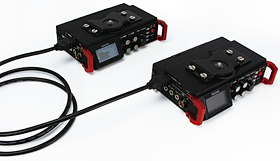
By connecting multiple units using HDMI, slave DR-701D units can be made to follow a master unit to start and stop recording simultaneously. Since audio can also be output through the HDMI connection, monitoring selections can be made using slave units without reconnecting headphones.
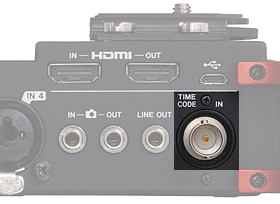
The built-in SMPTE generator allows the camera and DR-701D to store the same time reference. Several options are available to integrate SMPTE LTC into your camera system. The BNC timecode input can follow a source signal, or can be "jam-synced" a few times per day for independant freewheel operation. Cameras that send timecode through their HDMI output can be followed by the DR-701D's timecode input. And the internal generator can be started without an external reference for a simple time-of-day stamp on recorded BWF files.

Using the built-in mixer with four inputs and two outputs, four audio channels and their L-R stereo mix (six channels total) can be recorded simultaneously. In addition to pan and level adjustments, the mixer also includes a delay function that can compensate for distances between mics. A mid-side decoding function is also built in for use with mid-side stereo microphone setups.

The mic preamps that amplify the audio output from microphones have a significant impact on the quality of the recorded audio. The DR-701D features TASCAM HDDA mic preamps. The differential mic preamp circuits use discrete architecture and are made with carefully selected components. For example, op amps have a great impact on audio quality, so the OPA1652 by Texas Instruments was selected, which has even higher quality and lower noise than those used in the previous DR-70D model. As a result, the unit boasts an equivalent input noise of -124 dBu or better.
The A/D converters, which convert analogue signals to digital, are made by Asahi Kasei Corporation and are equivalent to those used in the top models in the TASCAM DR series of linear PCM recorders. High audio quality HDDA circuits faithfully convert amplified audio to digital. Resolutions up to 96 kHz/24-bit are supported when recording six channels and 192 kHz/24-bit when recording two channels.
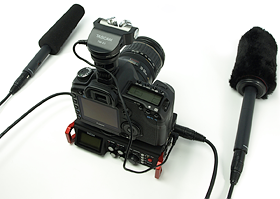
The DR-701D has four XLR/TRS inputs. The ability to adjust input levels independently and the availability of four channels make it possible to do separate miking of ambience and individual sound sources by utilizing two shotgun mics and one stereo mic. Since a 3.5-mm stereo input can be selected for channels 1-2 and the built-in omni mics for channels 3-4, an even wider range of mic setups are possible.

A limiter function that automatically adjusts excessive input levels is included for all four inputs. A more natural sound quality is achieved because a multiband limiter is employed to affect only the frequency ranges that have excessive input. In addition, a five-stage low-cut filter can be adjusted to cut wind noise, rumble and other undesirable low frequencies.
Safety files can be created by recording two audio files simultaneously at different levels in case the main recording clips due to unexpected input overloading.
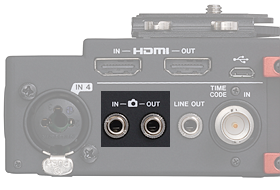
A dedicated connector is included to output mixed audio to the DSLR or video camera. This way, the same audio can be recorded by both the DR-701D and the camera. The output level has been made adjustable considering that input levels differ among camera manufacturers and input adjustments on cameras are limited.
A camera input makes it possible to monitor the audio from the DSLR camera during playback. By using this with the DR-701D monitor selection function, you can easily listen to not only the DR-701D but also audio from the DSLR camera.

The external input can be used to connect video camera mics that have stereo mini jack outputs (like the TASCAM TM-2X). One possible setup is to connect a video camera mic to the EXT IN 1/2 input for recording ambience, and XLR shotgun mics to inputs 3-4. Plug-in power can also be supplied to the mini jack input for those mics needing it.
A slate tone generator is built-in to guide alignment in post production. By zooming into the waveform of both the camera and DR-701D audio, the sine wave can be perfectly aligned for exact synchronization. In addition to producing tones automatically at the start (or start and end) of recording, slate tones can also be produced at any point by the press of a button.

The HOLD switch makes it possible to disable unintended operation in order to prevent misoperation of the controls on the front panel, starting with the 4 gain adjustment knobs. Another example of the various design features for preventing misoperation are the handles on the left and right sides that protect the control surface while also enabling attachment of a shoulder strap. In addition, the gain adjustment knobs are designed so they are not moved with a slight touch, making unintended moves less likely. Other details implemented for ease-of-use include an LCD screen and LEDs that promote high visibility even under direct sunlight.
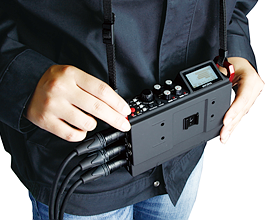
The DR-701D can be used as a six-channel field recorder with four input channels. Attach a strap to the red handles for comfortable outdoor use. Whether hung around the neck or shoulder, the unit can be easily operated and adjusted.

The unit is composed of a magnesium alloy that is very durable for a lightweight, but solid structure. While including abundant input connections, it was also designed for high mobility even when a camera support system or stabilizer is attached. Screw threads for mounting a tripod are included on the bottom of the unit, while a camera attachment screw and hot shoe (that can be removed) are included on the top of the unit. The DR-701D can be set up in a manner for the best handling. For example, it can be installed between a tripod and a camera, or attached to the top of the camera using a shoe mount.
In addition to operation using 4 AA batteries, even longer operation is possible with support for power supplied from a mobile battery with a Mini-B USB port. The TASCAM BP-6AA battery pack is also compatible.
| Maker | Model | HDMI Clock Sync |
Start/Stop Trigger |
HDMI Timecode |
Notes |
|---|---|---|---|---|---|
| Canon | EOS 5D Mark III | OK | OK | OK | |
| EOS 7D Mark II | OK | OK | OK | ||
| EOS C100 | OK | OK | OK | ||
| GoPro | HERO4 | OK | — | — | |
| HERO3+ | OK | — | — | ||
| JVC | GY-LS300 | OK | OK | OK | |
| Nikon | D5 | OK | — | — | |
| D500 | OK | — | — | ||
| D4S | OK | OK | — | Firmware C:Ver.1.30 or later |
|
| D810 | OK | OK | — | Firmware C:Ver.1.10 or later |
|
| D750 | OK | OK | — | Firmware C:Ver.1.10 or later |
|
| Panasonic | DMC-GH4 | OK | OK | OK | BODY Firmware Ver.2.5 or later |
| HC-X1000 | OK | — | OK | ||
| Sony | PXW-FS5 | OK | OK | OK | |
| NEX-FS700 | OK | OK | OK | ||
| NEX-FS100 | OK | — | OK | ||
| α7S II | OK | OK | OK | ||
| α7R II | OK | OK | OK | ||
| α7S | OK | OK | OK | ||
| α7 II | OK | OK | OK | ||
| DSC-RX10M2 | OK | OK | OK |
| General | ||
|---|---|---|
| Recording media | SD card (64 MB − 2 GB) SDHC card (4–32 GB) SDXC card (48–128 GB) |
|
| Recording and playback formats | WAV: 44.1 kHz, 48 kHz, 96 kHz, 192 kHz, 16/24 bit BWF: 44.1 kHz, 48 kHz, 96 kHz, 192 kHz, 16/24 bit |
|
| Number of input channels | 4 maximum (44.1/48/96 kHz) 2 maximum (192 kHz) |
|
| Number of recording channels | 6 maximum (44.1/48/96 kHz) 2 maximum (192 kHz) |
|
| Analogue audio inputs and outputs | ||
|---|---|---|
| IN 1–4 combo jacks | XLR-3-31 (1: GND, 2: HOT, 3: COLD) (XLR jacks can provide phantom power) 6.3-mm standard TRS jacks (Tip = HOT, Ring = COLD, Sleeve = GND) |
|
| Input gain set to LOW, MID, HI or HI+ | ||
| Input impedance | 2 kΩ | |
| Phantom Power | 48 V ±4 V (10 mA/channel) or 24 V ±4 V (10 mA/channel) |
|
| Maximum input level | +4 dBu | |
| Minimum input level | –72 dBu | |
| Mic input gain (input level knob at maximum) | LOW: +20 dB MID: +40 dB HI: +52 dB HI+: +64 dB |
|
| Input gain set to LINE | ||
| Input impedance | 10 kΩ or higher | |
| Nominal input level | +4 dBu | |
| Maximum input level | +24 dBu | |
| Additional input (EXT IN 1/2) | 3.5-mm stereo mini jack (can provide plug-in power) | |
| Input impedance | 10 kΩ | |
| Maximum input level | +10 dBV | |
| Minimum input level | −50 dBV | |
| Mic input gain (input level knob at maximum) | LOW: +3 dB MID: +11 dB HI: +26 dB HI+: +38 dB |
|
| Camera input | 3.5-mm stereo mini jack | |
| Input impedance | 10 kΩ | |
| Nominal input level | –10 dBV | |
| Maximum input level | +6 dBV | |
| Headphones output (PHONES) | 3.5-mm stereo mini jack | |
| Maximum output power | 50 mW + 50 mW | |
| Camera output | 3.5-mm stereo mini jack | |
| Output impedance | 200 Ω | |
| Nominal output level | –44 dBV | |
| Maximum output level | +6 dBV | |
| Notes: The maximum input level is the level that the input knob can be adjusted and a digital full-scale (0 dBFS) signal can be input without distorting. The minimum input level is the level that the input knob can be adjusted and a −20 dBFS signal can be input. | ||
| Line output (LINE OUT) | 3.5-mm stereo mini jack | |
| Output impedance | 200 Ω | |
| Nominal output level | –14 dBV | |
| Maximum output level | +6 dBV | |
| Other inputs and outputs | ||
|---|---|---|
| HDMI input/output (HDMI IN/OUT) | Type-A receptacle | |
| USB connector | Micro-B connector | |
| Format | USB 2.0 High Speed, mass storage class | |
| Timecode input (TIME CODE IN) | BNC | |
| Input signal voltage range | 0.5–5 Vpp | |
| Input impedance | 10 kΩ | |
| Format | SMPTE 12M-1999 compliant | |
| REMOTE connector | 2.5-mm TRS micro jack | |
| Audio performance | ||
|---|---|---|
| Frequency response | 20 Hz – 20 kHz +0.5/−1 dB (LINE IN to LINE OUT, Fs 48 kHz, JEITA) 20 Hz – 40 kHz +0.5/−1 dB (LINE IN to LINE OUT, Fs 96 kHz, JEITA) 20 Hz – 80 kHz +0.5/−5 dB (LINE IN to LINE OUT, Fs 192 kHz, JEITA) |
|
| Distortion | 0.007 % or less (Mic input to LINE OUT, −10 dBu input, Fs 44.1/48/96/192 kHz, JEITA) |
|
| S/N ratio | 100 dB or more (Line or Mic input to LINE OUT, Fs 44.1/48/96/192 kHz, JEITA) |
|
| Equivalent input noise (EIN) | −124 dBu or less | |
| Power supply and other specifications | ||
|---|---|---|
| Power supply | 4 AA batteries (alkaline, NiMH or lithium) AC adapter (Tascam PS-P515U, sold separately) or USB connection External battery pack (Tascam BP-6AA, sold separately) |
|
| Power consumption | 6.5 W (maximum) | |
| Current consumption (USB connection) | 1.3 A (maximum) | |
| Dimensions (W × H × D) | 169 mm × 57 mm × 114 mm (with camera adapter attached) | |
| Weight | 654 g (including batteries) 561 g (excluding batteries) |
|
| Permissible operating temperature range | 0–40 °C | |
Design and specifications subject to change without notice.
| Title | Type | Size | Download |
|---|---|---|---|
| DR-701D_OM_multi_RevB.pdf | 11.22MB | Download |